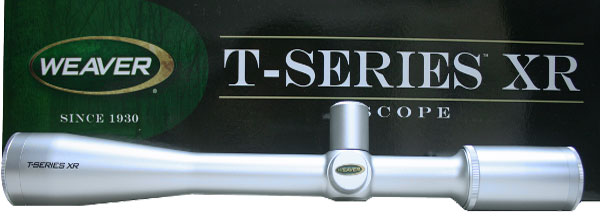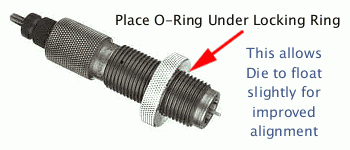New 46x48mm Weaver XR Target Scope with 30mm Tube
Weaver has a brand new, high-magnification, 46X target scope. Chances are you haven’t heard a thing about it — the new Weaver T-Series XR 46x48mm scope is so new you won’t even find it on the Weaver website. Compared to the older T-36, this new 46-power scope offers more magnification, more elevation, a larger front objective (48mm vs. 40mm), and a larger 30mm main tube (compared to 1″ for the old T-36). The new XR 46X Weaver also features side-focus parallax control. That’s a big change. You could instantly spot a classic Weaver T-36 by the adjustable front objective with its knurled ring and yardage markings. The T-Series XR 46X (as well as the new XR 24X and XR 36X) have the parallax control on the left side of the main tube (photo below).

 We have looked through the new Weaver 46X scope and it is very sharp. Brightness is good — it seems comparable with a Leupold 45x45mm Competition (but that was on a bright, sunny day). Initial tests show the clicks to be tactile and positive, but we haven’t had a chance to do a full “box test” to confirm tracking. Weaver claims the new XR series scopes will focus down to 50 feet, but with the 46X we had some questions about its extreme close-focus capability. If you’re shooting beyond 50 yards, the focus should be fine.
We have looked through the new Weaver 46X scope and it is very sharp. Brightness is good — it seems comparable with a Leupold 45x45mm Competition (but that was on a bright, sunny day). Initial tests show the clicks to be tactile and positive, but we haven’t had a chance to do a full “box test” to confirm tracking. Weaver claims the new XR series scopes will focus down to 50 feet, but with the 46X we had some questions about its extreme close-focus capability. If you’re shooting beyond 50 yards, the focus should be fine.
The new T-Series 46X XR is offered with two reticle choices, a fine cross-hair (FCH), or FCH with 1/16th MOA dot. Both reticles are well-suited for benchrest work. The current “street price” for the new 46X Weaver is $829.95. That’s way more than the old T-36, but it undercuts Leupold fixed-power competition scopes by hundreds of dollars. We know of only two vendors who currently carry the Weaver 46X. These are Killough Shooting Sports, and Bruno Shooters Supply.

 New 24X and 36X T-Series XR Scopes with Side-Focus and 1″ Tubes
New 24X and 36X T-Series XR Scopes with Side-Focus and 1″ Tubes
The new 46-power XR scope is the star of the XR line-up. Designed to go head-to-head with Leupold’s 45X Competition scope, the 46X Weaver XR offers a modern 30mm main-tube and large (48mm) front objective. If you don’t need the bigger tube and larger objective, but still want side-focus parallax control, Weaver offers two other new XR scopes — a 36x40mm and a 24x40mm. These will both retail for under $600.
Dan Killough offers the black-finish 36-power XR for $559.95 and the black-finish 24-power XR for $549.95. Silver models are slightly more. These 1″-tube XR scopes are worth considering, but keep in mind that you can now purchase the older T-series scopes with adjustable front objectives for well under $400.00. For benchrest shooting at a fixed distance, side-focus is not necessary; adjustable front objectives work just fine. Just set and forget.





















